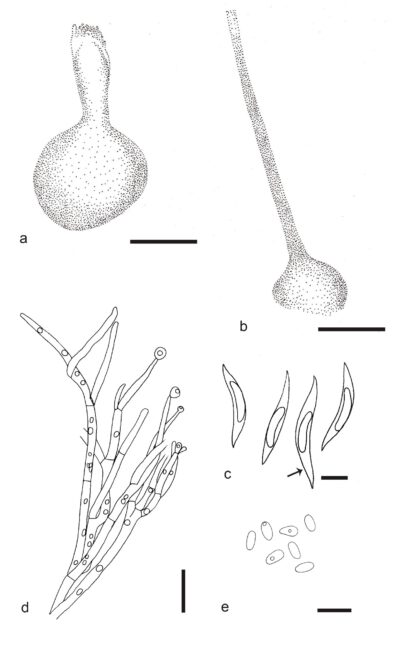Fungalpedia – Note 272, Aureovirgo
Aureovirgo J.A. van der Linde, Z.W. de Beer & Jol. Roux
Citation when using this entry: Perera et al. 2024 (in prep) – Fungalpedia, genera described in 2016.
Index Fungorum, Facesoffungi, MycoBank, GenBank, Fig 1
Classification: Ophiostomataceae, Ophiostomatales, Diaporthomycetidae, Sordariomycetes, Pezizomycotina, Ascomycota, Fungi
van der Linde et al. (2016) introduced the monotypic genus Aureovirgo to accommodate A. volantis, based on ITS, LSU, and tub2 markers. Aureovirgo volantis associated with Cyrtogenius africus galleries in diseased Euphorbia ingens (van der Linde et al. 2016). Bases of immature ascomata are honeycolored and become fuscous when mature with dark necks. Ostiolar hyphae are hyaline. Ascospores are allantoid that have ellipsoidal sheaths. Aureovirgo forms a leptographium-like asexual morph. Conidiophores are mononematous and hyaline, with a simple and cylindrical stipe. Conidia are oblong-elliptical and oval ovate (van der Linde et al. 2016). Aureovirgo is phylogenetically most closely related to Graphilbum and species in the Sporothrix lignivora complex (van der Linde et al. 2016).
Type species: Aureovirgo volantis J.A. van der Linde, Z.W. de Beer & Jol. Roux
Other accepted species: This genus in monotypic
Figure 1 – Aureovirgo volantis (CMW41238, ex-type culture). a Immature ascocarp. b Mature ascocarp with ostiolar hyphae. c Allantoid ascospores with ellipsoidal sheath (arrow indicate ellipsoidal sheath). d Leptographium-like conidiophore with conidiogenous cells. e Oblong-elliptical and oval ovate conidia. Scale bars: a, c = 5 μm, b, d = 10 μm. Redrawn from van der Linde et al. (2016).
Reference
Entry by
Rekhani Hansika Perera, Center of Excellence in Fungal Research, Mae Fah Luang University, Chiang Rai, 57100, Thailand.
(Edited by Kevin D. Hyde, Samaneh Chaharmiri-Dokhaharani, & Achala R. Rathnayaka)
Published online 28 May 2024
